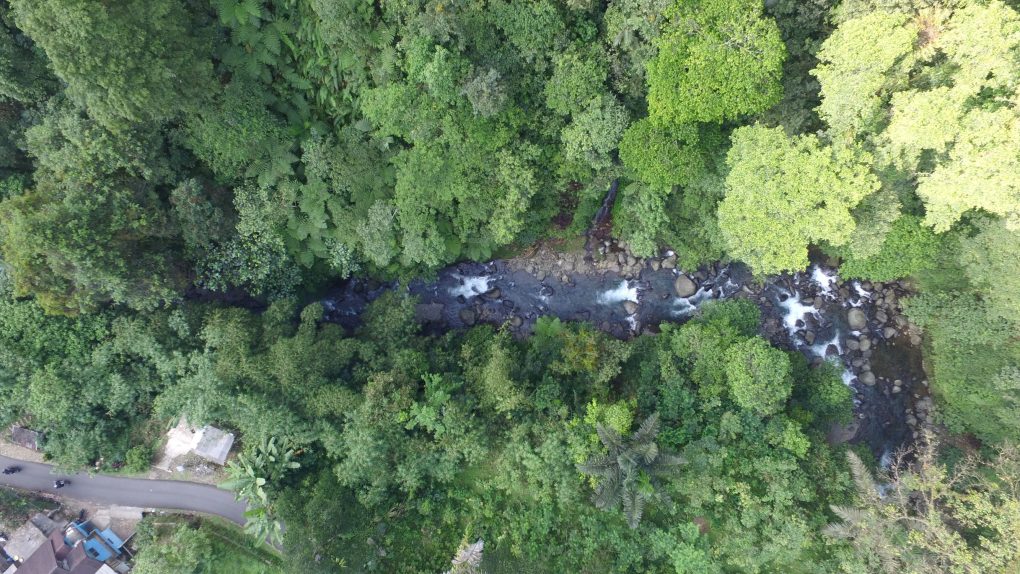The sighting of a Javan blue-banded kingfisher in Petungkriyono in October 2018 (report in Chan & Setiawan 2019) gives us renewed hope that this globally very rare bird may still be clinging on to existence in undersurveyed areas. However, trying to conserve the bird at that particular site in the western part of the Dieng Mountains also presents us with some challenges.
Prior to the Petungkriyono sighting, this endemic to Java was only reported from two national parks in West Java in recent years: Halimun Salak and Gede Pangrango. It had also been recorded from six other locations by naturalists and researchers during the colonial era, namely Jasinga, Cimarinjung, Pelabuhanratu, and Cikahuripan (West Java), Rampoa (Central Java), and Kali Sanen (East Java), but seems to have vanished from these sites.
Even at sites it is known to inhabit, the Javan blue-banded kingfisher, whose scientific name is Alcedo euryzona, is rarely encountered. Nowhere is it common, and it can only be found in lowland rainforests where there is an abundance of clean water, rocky streams and rivers. This bird is therefore known as a river-dependent species.
In Java, there are not many sites left which fulfil these specific habitat criteria. Those that still exist are likely to be protected or in reserves. This is indeed the case for the Petungkriyono forest, which is a protected forest area managed by Perhutani, the state-owned enterprise overseeing the use of forest resources. In recognition of its importance to both humans and wildlife, the Petungkriyono forest has now been classified as an Essential Ecosystem Area to be managed collaboratively by different stakeholders.
While protected status is a good first step, it falls short of ensuring that the area is fully safe from encroachment. Various communities have long inhabited the area around the Petungkriyono forest, for which reason the forest is important not only to its flora and fauna, but also as a source of livelihood to local people. We therefore expect the development of the local economy, including that of tourist attractions, to continue apace. Faced with this considerable challenge, all parties who have a stake in the Petungkriyono forest need to be actively involved in protecting the Javan blue-banded kingfisher if the bird is to be guranteed a future.
Another challenge that must be overcome stems from how little we know about this kingfisher. Can it be found along all rivers in the forest? What exactly are the conditions it needs to survive? We have yet to find answers to even these basic questions, not to mention those details about the bird’s behaviour, diet, population size, breeding patterns, and so on.
Conducting such a baseline study is of the utmost importance because the total Javan blue-banded kingfisher population worldwide is estimated to number less than 250 individuals. In other words, this is a Critically Endangered species by IUCN Red List standards, only one level removed from extinction in the wild.
The SwaraOwa is firmly committed to protecting the Javan blue-banded kingfisher. A group of young people who previously started initiation of community development and conservation for Javan gibbon (Hylobates moloch) and Mentawai Gibbon ( Hylobates klosii), now have been try to enhance biodiversity value within the gibbons habitat of this region. We are actively involved in efforts to encourage the collaborative management of the Petungkriyono forest area. We are also working closely with the local community to collect field data and find out more about the bioecology of this kingfisher. With the support of the Asian Species Action Partnership (ASAP) and the Oriental Bird Club (OBC), we hope to make the conservation of the Javan blue-banded kingfisher a reality.
—————————————————————————————————————–
Written in bahasa by : Imam Taufiqurrahman, e-mail : [email protected], and translation by TT Chan

